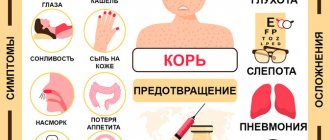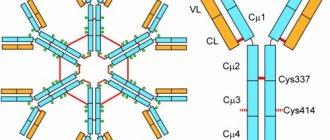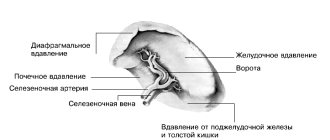Childhood infections are a group of infectious diseases that occur primarily in childhood and, after recovery, leave lasting immunity. Childhood infections include measles, rubella, chickenpox, scarlet fever, whooping cough, and mumps. Childhood infections occupy a leading place in the structure of childhood morbidity, despite the development of immunization.
Measles is an acute infectious disease. Characteristic manifestations of measles are an increase in temperature to 38-40.5 C, symptoms of intoxication (headache, weakness, loss of appetite, aches in muscles and joints), skin rash, inflammation of the mucous membrane of the nasopharynx, upper respiratory tract, eyes. The source of the disease is a sick person. The route of transmission is airborne. The causative agent of the infection is the RNA virus Polynosa Morbilarum. The measles virus is not resistant to physical and chemical factors. Remains in the environment for no more than 30 minutes.
The measles virus is highly contagious, with the highest incidence observed among children aged 1-5 years.
The disease begins acutely, the child's temperature rises to 38-39 C, catarrhal symptoms and symptoms of intoxication appear. On the 2-3rd day, the temperature decreases, and catarrhal symptoms increase. On the second day of the disease, whitish spots with a red border appear on the mucous membrane of the cheeks - Belsky-Filatov-Koplik spots; from days 3-5, skin rashes characteristic of measles appear. The rash descends from top to bottom: first it covers the upper part of the face, neck, then the torso, arms and legs. The rash is bright pink in color and consists of small maculopapular elements that tend to merge. The rash fades in the same order. After the rash, pigmentation and peeling remain on the skin.
Laboratory confirmation of measles is carried out using a molecular biological method (detection of virus RNA using polymerase chain reaction) and a serological method (detection of specific antibodies in the blood).
- Antibodies to measles virus (Measles), Anti-Measles, IgG, semi-quantitative determination.
- Measles virus (Measles), qualitative determination of IgM class antibodies.
The criteria for recovery from measles are: persistent normalization of temperature for 3 days or more, absence of signs of intoxication, absence of catarrhal phenomena in the oropharynx, extinction of the rash.
Chicken pox is an acute infectious disease. It manifests itself as fever, moderate intoxication and a polymorphic (spotty, vesicular, papular) rash on the skin. The route of transmission is airborne. The source of the disease is a sick person. The causative agent of chickenpox is the DNA-containing Varicella Zoster virus, which belongs to the herpes family.
The clinical picture of a typical form of chickenpox consists of several periods: incubation, prodromal, period of rash and period of reverse development.
The incubation period ranges from 11 to 21 days.
The prodromal (initial) period lasts from several hours to two days. It is characterized by moderate intoxication, low-grade fever, exanthema syndrome - a pinpoint rash appears on the skin, which precedes the appearance of typical rashes.
During the period of rash, the temperature rises to febrile levels, and moderately severe symptoms of intoxication appear. Elements of a macular vesicular rash appear on the skin, on the mucous membrane of the oropharynx, on the tongue, rarely on the mucous membrane of the eyes and conjunctiva. Vesicles (bubbles) are round or oval in shape, with transparent contents. New rashes appear within 2-5 days, in spurts. Then the chickenpox elements gradually dry out, crusts form and light pigmentation on the skin. Each new wave of rashes is accompanied by an increase in body temperature. There is a direct relationship - the more pronounced the rash, the more severe the symptoms of intoxication in patients with chickenpox.
Chicken pox can have complications. These are inflammatory diseases of the skin and subcutaneous fat - pyoderma, phlegmon. Pneumonia, myocarditis, nephritis, hepatitis, and arthritis occur rarely. Possible damage to the nervous system - encephalitis.
Diagnosis of chickenpox
Chickenpox is diagnosed primarily by the typical clinical picture.
In laboratory diagnostics, to identify the causative agent of chickenpox, the polymerase reaction method and determination of the DNA of the virus are used.
- Varicella-Zoster virus (VZV), qualitative determination of DNA.
- Varicella-Zoster virus (VZV), qualitative determination of DNA (whole blood).
Serological diagnosis is aimed at identifying specific antibodies to the varicella zoster virus:
- Varicella-Zoster virus (VZV), IgM.
- Varicella-Zoster virus (VZV), IgG.
The microscopic method is used to verify the causative agent of chickenpox - identification of Aragao bodies (virus accumulation) in a smear from the contents of the vesicle, stained with silver by Morozov.
Scarlet fever is an acute infectious disease caused by group A beta-hemolytic streptococcus. It is characterized by fever, intoxication, acute tonsillitis and pinpoint rash.
The causative agent of scarlet fever is group A beta-hemolytic streptococcus. Scarlet fever is transmitted by airborne droplets. The source of infection is a sick person or a bacteria carrier.
2) Ear inflammation
Why are young children prone to ear infections? Their auditory tubes are narrow and located horizontally. When the throat becomes inflamed, they can become blocked, causing fluid behind the eardrum to become trapped inside the middle ear, allowing germs to multiply. The child's temperature rises, he shows anxiety, and tries to pull his ears back. Many ear infections are caused by viruses and go away on their own. Vaccination helps prevent infection by certain microorganisms that can cause ear infections. But some inflammatory ear diseases require treatment with antibiotics.
Clinical picture of scarlet fever
The incubation period for scarlet fever usually lasts 2-3 days, with a maximum of 7 days.
At the beginning of the disease, symptoms of intoxication appear, redness of the mucous membrane of the pharynx and tonsils, a pinpoint small rash (enanthema) on the soft palate, and tonsillitis gradually develops.
This is followed by a period of rashes: a pinpoint bright pink rash appears on the skin of the torso, the flexor surface of the arms, and the inner surface of the legs. The rash thickens in the natural folds of the skin and is located against a background of redness. The rash associated with scarlet fever is characterized by the absence of a “spilling” effect. The skin rash can be hemorrhagic (pinpoint hemorrhages) or small papular (small tubercles). The rash is absent in the area of the nasolabial triangle - this is one of the diagnostic signs of scarlet fever (Filatov syndrome). Another characteristic symptom is the bright crimson color of the tongue.
By the 4th day of illness, the rash fades and becomes pale pink. From the second week of the disease, a period of recovery (convalescence) begins, during which lamellar peeling appears on the palms and soles.
Complications of scarlet fever - otitis media, sinusitis, myocarditis, nephritis.
To laboratory confirm the diagnosis of scarlet fever, serological methods are used - identifying specific antibodies Ig M, Ig G in the blood and increasing the level of antibodies to streptolysin O.
- Anti-streptolysin O.
The causative agent of scarlet fever can be identified by the cultural method - when sowing on artificial nutrient media.
- Microbiological (culture) test for beta-hemolytic streptococcus group A (Streptococcus group A, S.pyogenes).
- Microbiological (culture) test for beta-hemolytic streptococcus group A (Streptococcus group A, S.pyogenes) with determination of sensitivity to antimicrobial drugs.
Mumps is an acute infectious disease. Mumps is manifested by fever, symptoms of intoxication, inflammation of the salivary glands, damage to other glandular organs and the nervous system.
Mumps is transmitted by airborne droplets and household contact. The source of infection is a sick person.
The causative agent of mumps is the Mumps rubulavirus virus, which contains RNA and belongs to the paramyxovirus family.
The incubation period lasts from 11 to 21 days, usually 15 days. The onset of the disease is acute, with an increase in temperature, symptoms of intoxication, swelling and pain in the parotid gland appear. It is customary to distinguish between intoxication syndrome and glandular organ damage syndrome.
Intoxication syndrome - headache, loss of appetite, weakness, fever up to 38-40°C.
Glandular organ damage syndrome. The parotid salivary glands increase in size, pain appears, and swelling of the surrounding subcutaneous fat is possible. The face becomes round, the neck appears thicker. The popular name for mumps, mumps, was given to the disease for the characteristic appearance of the patient. The atypical form of mumps can occur without damage to the salivary glands.
Over the course of several days, other salivary glands – sublingual, submandibular – may also become involved in the pathological process.
Damage to the pancreas - occurs in 20-40% of cases, manifested by symptoms of pancreatitis - abdominal pain, nausea, vomiting, constipation. Damage to the gonads in boys (orchitis) develops acutely, on the 6-7th day of illness, as a rule, the process is one-sided. Characterized by a rise in temperature, pain in the testicle, which can spread to the groin area, to the inner surface of the thigh. The testicle increases in size and becomes dense in consistency. Symptoms last 3-5 days and disappear completely within 7-10 days.
Damage to the female reproductive glands (oophoritis) in girls is quite rare and can occur during puberty.
Syndrome of damage to the central and peripheral nervous system is also a rare phenomenon, most often occurring in children aged 3-9 years. Manifested by severe weakness, drowsiness, meningeal symptoms, convulsions, impaired consciousness.
Complications of mumps include arthritis, nephritis, inflammation of the cranial nerves (myelitis), meningoencephalitis, and encephalitis. When diagnosing mumps, special attention is paid to the clinical picture: swelling of the parotid glands, pain when chewing, fever, intoxication. Diagnostically significant are Murson's symptom (redness and inflammatory reaction of the mucous membrane around the duct of the inflamed parotid gland); Filatov's symptom (pain when pressing behind the earlobe). Laboratory diagnostics.
To detect pathogen RNA, a molecular biological method is used - polymerase chain reaction (PCR). A serological method is also used - determination of specific antibodies Ig M, Ig G in blood serum:
- Mumps virus (Mumps), qualitative determination of IgG antibodies.
- Mumps virus (Mumps), qualitative determination of IgM class antibodies.
With pancreatitis, a biochemical blood test reveals an increase in the amylase enzyme.
3) Exudative otitis media
Exudative otitis media (EO) is characterized by the accumulation of fluid in the middle ear behind the eardrum without signs of acute infection. It often occurs as a result of an inflammatory ear disease or upper respiratory tract infection. The exudate usually goes away on its own after two to three weeks. However, if it lingers, becomes thick and sticky (“gummy ear”), it can negatively affect the child’s hearing, cause pain and infection. Your pediatrician may refer you to an otolaryngologist to prescribe the necessary treatment.
Treatment of childhood infections
To prevent the spread of infection, the first step is to isolate the patient at home or in a specialized hospital. In moderate and severe cases of the disease, the child must be hospitalized in a hospital, in a boxed ward. The mild form is treated on an outpatient basis, at home.
For the treatment of infections of viral etiology - measles, rubella, chickenpox, mumps, antiviral drugs are recommended. Therapy for scarlet fever and whooping cough is based on the prescription of antibacterial drugs.
Treatment is also recommended to block the pathological mechanisms of disease development and alleviate the symptoms of childhood infections.
How can you protect your child from infections?
Pregnant women and those who are just planning motherhood should be extremely careful, because some infectious agents can penetrate the fetus through the placenta, causing congenital diseases and various malformations.
It should be borne in mind that infectious diseases in children's groups are transmitted very quickly, because children are constantly in contact with each other and sometimes neglect the rules of hygiene. Therefore, if you find signs of an infectious disease in your child, he must be isolated, that is, temporarily stop attending kindergarten or school. This is necessary, firstly, to maintain bed rest, because high physical activity during illness can lead to the spread of infection throughout the body. Secondly, in this way you will protect other children from infection.
Do not forget that some infectious diseases are transmitted to children and from parents. For example, gastritis and gastric ulcers can also be the result of an infection - the presence of Helicobacter pylori in the digestive system (do a Helicobacter test), which can be transmitted through saliva. Therefore, it is extremely undesirable to use the same spoon or fork with your child.
To prevent the occurrence of intestinal infections, you should sterilize children's dishes, heat-treat food, and in the future teach your baby to wash their hands after using the toilet and before eating.
Vaccinations and strengthening children's immunity
Vaccination, which is carried out in our clinic by experienced staff, plays a huge role in the prevention of infectious diseases. Weakened infectious agents or their components are introduced into the child’s body. In response, the child's immune system begins to produce antibodies, and before a real infectious disease, your child will already be completely protected.
Undesirable consequences from the introduction of vaccines are still observed, so our doctor must examine the baby before vaccination. Some vaccines are not administered to weakened and sick children; they must wait until they recover. Most doctors believe that a slight increase in body temperature and mild malaise are a normal reaction of the body to the vaccine. By vaccinating your child in our clinic, you protect him from many serious infectious diseases.
For the purpose of emergency prevention, ready-made protective antibodies are used. However, after some time they die, and the child loses passive immunity.
If your baby suffers from infectious diseases more than 8-10 times a year, there is also a reason to consult an immunologist to assess the functioning of the immune system.
Vaccinal prevention of childhood infections
Currently, preventive vaccinations against whooping cough, measles, rubella, and mumps are included in the national vaccination calendar of the Russian Federation. Preventive vaccination against chickenpox is included in the list of preventive vaccinations for epidemic indications.
Bibliography.
- Clinical recommendations (treatment protocol) for providing care to children with chickenpox.
- Clinical guidelines “Measles in children” (approved by the Russian Ministry of Health), 2015.
- Clinical recommendations (treatment protocol) for providing assistance to children with scarlet fever.
- Clinical recommendations (treatment protocol) for providing care to children with mumps.
Causes of pathologies
The main cause of school diseases is unsatisfactory organization of education:
- overwork due to excessive mental and physical stress;
- poor classroom lighting;
- discrepancy between the dimensions of the furniture and the height of the child;
- prolonged sitting in an incorrect position;
- lack of physical activity;
- violation of diet and snacking on the go;
- poor living conditions;
- unfavorable psychological atmosphere in the family;
- frequent stress.
Our information
Childhood infections are the name given to a group of infectious diseases that people contract mainly during childhood.
These usually include varicella (chickenpox), rubella, mumps (mumps), measles, scarlet fever, polio, whooping cough, and diphtheria. Infections are transmitted from a sick child to a healthy child. After an illness, a stable (sometimes lifelong) immunity is formed, so people rarely get sick with these infections again. Now there are vaccines for almost all childhood infections.
Related article: Children's infections in figures and facts: whooping cough lasts 7 weeks, and scar rash
Rubella
Article on the topic
Measles, rubella and mumps. How dangerous are “childhood” diseases for adults? The rubella virus is transmitted from a sick person by airborne droplets. The incubation period is 11–23 days. A person infected with rubella begins to secrete the virus a week before the onset of clinical symptoms and ends a week or two after all signs of the disease have disappeared.
A typical manifestation of rubella is swelling and mild tenderness of the posterior cervical, occipital and other lymph nodes. At the same time (or 1–2 days later), a pale pink, small-spotted rash appears on the face and entire body. After another 2-3 days it disappears without a trace. The rash may be accompanied by a slight rise in body temperature and slight disturbances in the functioning of the respiratory tract. But often such symptoms do not occur.
Complications are extremely rare. Rubella is dangerous only if a pregnant woman contracts it, especially in the first months. The disease can cause severe fetal malformations.
Treatment
There is currently no specific treatment for rubella. In the acute period, the patient must remain in bed. When the temperature rises, antipyretic drugs are used, and for an itchy rash, antihistamines are used.
Prevention
Not long ago, the rubella vaccine was introduced into the National Calendar.
Preventive actions
To prevent the development of pathologies, it is necessary to maintain a daily routine, alternate work and rest, exercise regularly, eat rationally, and sit at a desk in the correct position. The child should walk in the fresh air and sleep enough time.
School medical examinations, matching the size of furniture to the child’s height, and creating a calm atmosphere in the home are important for the prevention of diseases.
You shouldn’t worry too much about your child and try to isolate him from society by creating greenhouse conditions. On the contrary, it is necessary to harden it and strengthen the immune system.










